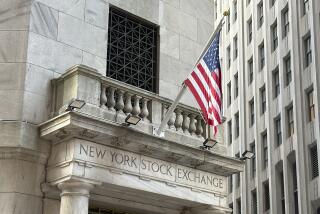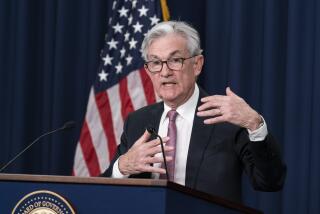Wholesale prices rise mild 0.2%
- Share via
WASHINGTON — Inflation at the wholesale level slowed in April after a huge increase in March, although prices for a number of items from prescription drugs to pasta shot upward.
The Labor Department reported Tuesday that wholesale inflation increased 0.2% in April after a 1.1% jump in March. Outside of food and energy, prices rose 0.4% in April.
The overall moderation in prices primarily reflected how the government adjusts its data to compensate for seasonal changes. Those adjustments showed gasoline prices falling last month even though motorists were seeing prices soar.
The 0.2% increase for the department’s producer price index was lower than expectations, but the 0.4% rise excluding food in energy was double what economists had expected.
It left inflation outside of food and energy rising by 3% over the last 12 months, the fastest increase for a 12-month period since late 1991.
The report on the PPI, which measures price pressures before they reach consumers, followed news last week that consumer prices rose just 0.2% in April even though food costs soared by the largest amount in 18 years.
At the wholesale level, food prices were unchanged last month after having jumped by 1.2% in March. The flat overall reading for food masked wide variations, however.
Prices for vegetables dropped 4.1%, while egg costs fell 12.3%, the biggest one-month decline since June.
However, the cost of rice soared 17.4%, the biggest increase since November 1993, while bakery products rose 1.1%.
Energy prices fell 0.2% in April after a 2.9% surge in March. The PPI report showed that gasoline costs fell 4.6%. However, that decline reflected the government’s seasonal adjustment methods. Since gasoline prices rose less than they usually do in April, that translated into a decline in the government’s figures.
That was little comfort for motorists who are paying record prices with gasoline hitting a national record of $3.80 a gallon Tuesday, according to a survey by AAA and the Oil Price Information Service.
The 0.4% rise in core inflation, which excludes food and energy, came after a 0.2% rise in March. This price acceleration reflected gains in a number of areas such as a 0.7% increase in the category that includes prescription and over-the-counter drugs.
Prices for passenger cars rose 0.4% while prices for commercial furniture rose 1.8%, the biggest one-month increase since February 1981.
The increased price pressures are occurring at the same time that the economy has slowed dramatically, increasing worries that the country could face another bout of stagflation, the malady that last occurred in the 1970s when successive oil price shocks sent inflation soaring as growth stagnated.
More to Read
Inside the business of entertainment
The Wide Shot brings you news, analysis and insights on everything from streaming wars to production — and what it all means for the future.
You may occasionally receive promotional content from the Los Angeles Times.










